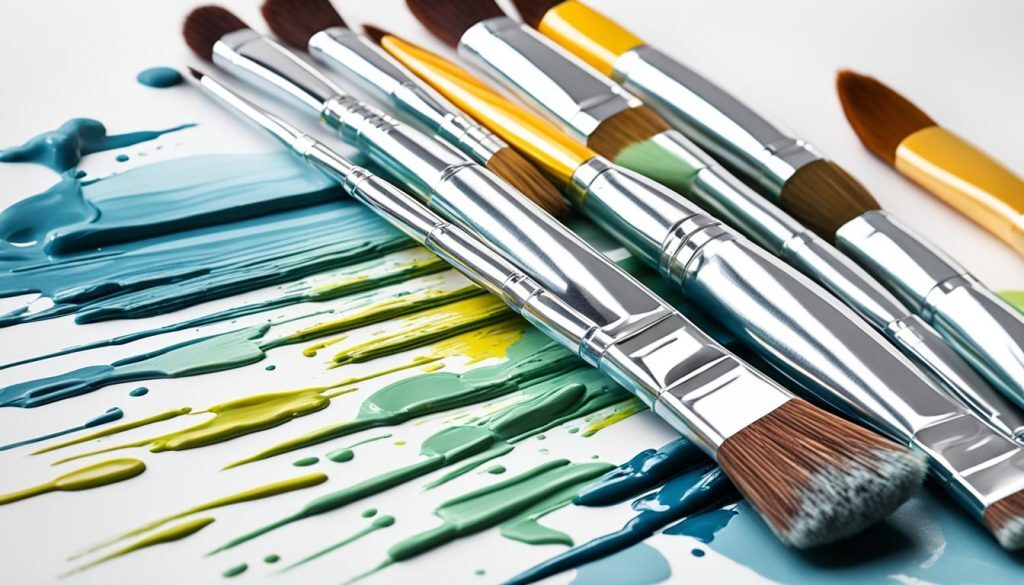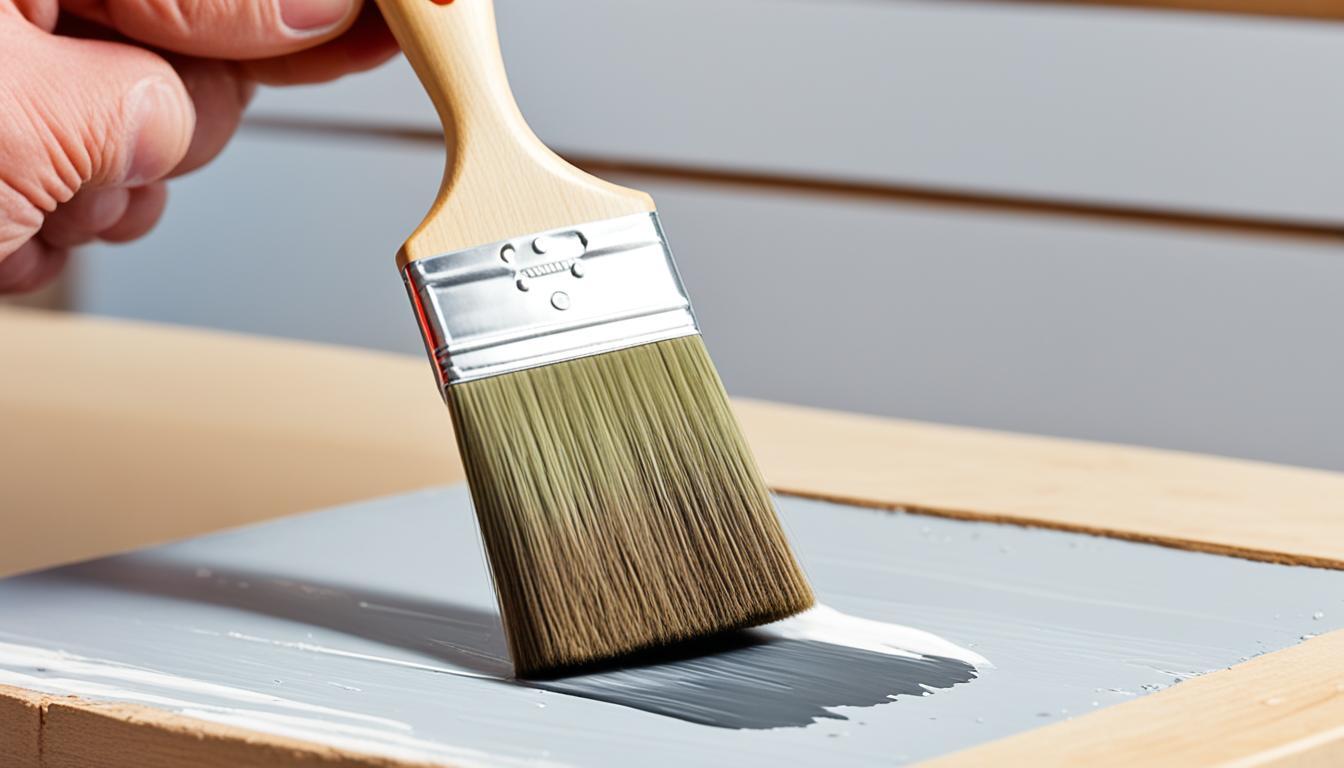Did you know that choosing the right brush can make all the difference when it comes to painting cabinets? It’s true! Using the best brush for painting cabinets can help you achieve a flawless finish and transform your space.
With so many options available, how do you know which brush is the best for the job? That’s where I come in. I have done the research and compiled a list of the top paint brushes for cabinets based on expert reviews and customer feedback.
Whether you’re a professional painter or a DIY enthusiast, these brushes are sure to meet your needs and help you achieve stunning results. So let’s dive in and discover the top brush picks for painting cabinets!
Key Takeaways:
- Choosing the right brush is crucial for achieving a flawless finish when painting cabinets.
- Expert reviews and customer feedback were considered to compile the list of the top paint brushes for cabinets.
- These brushes are suitable for both professionals and DIY enthusiasts.
- Using the best brush for painting cabinets can help transform your space.
- Stay tuned to discover the top brush picks for painting cabinets!
Best Brushes for Painting Cabinets
When it comes to professional cabinet painting, using the highest rated brush is essential for achieving a flawless finish. The right brush can make all the difference in refinishing your cabinets and giving them a stunning makeover. After extensive research and considering expert reviews and user feedback, I have identified the recommended brush for cabinet makeover – the Purdy Cub Angle Brush XL.
This professional cabinet painting brush is designed to work with all paints and stains, making it highly versatile for any cabinet refinishing project. Its nylon-polyester bristles ensure a smooth finish, eliminating brush strokes and leaving your cabinets with a professional look.
| Brush | Features |
|---|---|
| Purdy Cub Angle Brush XL | Designed for all paints and stains Nylon-polyester bristles for a smooth finish |
The Purdy Cub Angle Brush XL is especially beneficial when painting the various smaller surfaces of cabinets. Its angled bristles allow for precise application and easy maneuverability, ensuring that every nook and cranny is covered with precision. This brush provides excellent control and delivers professional results, making it the top choice for painters and DIY enthusiasts.
Investing in a professional cabinet painting brush like the Purdy Cub Angle Brush XL will elevate your cabinet makeover experience and help you achieve a flawless finish. So, why settle for less when you can have the best? Choose the highest rated brush for cabinet refinishing and create stunning cabinets that will impress everyone.
Spray Paint vs. Brush Paint for Cabinets: Which is Better?
When it comes to painting cabinets, one of the main decisions you’ll have to make is whether to use spray paint or brush paint. Each method has its advantages and considerations, so it ultimately comes down to your preferences and the scope of your project.
Spray Paint:
Spray paint offers a quick and efficient way to cover large surfaces, making it ideal for large-scale cabinet refinishing projects. It provides a smooth, even finish and can save you time compared to using a brush. Additionally, spray paint allows for easy application and minimal brush strokes, resulting in a professional-looking finish.
Brush Paint:
Brush paint, on the other hand, offers more control and precision, making it the preferred option for smaller cabinet painting jobs or when you want to achieve a specific look or texture. Using a high-quality brush, such as the Purdy Ultra Finish Brush, ensures a smooth application, minimizing the risk of visible brush strokes.
If you’re looking for the best brush for kitchen cabinet painting or premium brushes for cabinet refinishing, consider brushes made with high-quality materials, such as natural bristles or a combination of synthetic and natural bristles. These brushes offer better paint pick-up and release, resulting in a smoother, more professional finish.
Ultimately, the choice between spray paint and brush paint depends on the specific requirements of your cabinet painting project. If you’re refinishing a large number of cabinets and want a quick and efficient solution, spray paint may be the better choice. However, if you’re looking for more control and precision, or if you’re working on smaller cabinets, using a high-quality brush can give you the best results.

How to Eliminate Brush Strokes When Painting Cabinets
To achieve a flawless finish and eliminate brush strokes when painting cabinets, follow these tips:
- Choose the right brush: Opt for a high-quality brush specifically designed for precision painting. Look for brushes with fine bristles that are suitable for smooth surfaces like cabinets.
- Use the correct brush technique: Instead of using long strokes, use shorter and lighter brush strokes. This will help minimize the appearance of brush marks.
- Thin the paint: If you’re using a brush-on paint, consider thinning it slightly with water or a specialized paint conditioner. Thinning the paint can help it flow more smoothly and reduce the visibility of brush strokes.
- Apply multiple thin coats: Instead of applying a thick coat of paint, apply multiple thin coats. This allows each coat to dry thoroughly and helps achieve a smoother finish. Sand lightly between coats to further eliminate any brush marks.
- Sand the surface: Before painting, make sure to sand the cabinets to create a smooth surface. This helps the paint adhere better and reduces the likelihood of brush strokes appearing.
- Consider brush alternatives: If you’re still struggling to eliminate brush strokes, you might consider using a foam roller or a paint sprayer to achieve an even finish. These tools can help eliminate brush marks and provide a more uniform coat of paint.
By following these tips, you can successfully eliminate brush strokes and achieve a professional-looking finish when painting cabinets.
| Tip | Description |
|---|---|
| Choose the right brush | Opt for a high-quality brush with fine bristles designed for precision painting. |
| Use the correct brush technique | Use shorter and lighter brush strokes instead of long strokes to minimize brush marks. |
| Thin the paint | Consider thinning brush-on paint with water or a paint conditioner to help it flow smoothly and reduce brush strokes. |
| Apply multiple thin coats | Apply multiple thin coats of paint, allowing each coat to dry thoroughly. Lightly sand between coats to eliminate brush marks. |
| Sand the surface | Sand the cabinets before painting to create a smooth surface for better paint adhesion. |
| Consider brush alternatives | If brush strokes persist, try using a foam roller or paint sprayer for a more even finish. |
Follow these tips and use the right techniques and tools to achieve a flawless finish without any visible brush strokes.

Additional Factors to Consider When Selecting Brushes for Cabinet Painting
When it comes to cabinet painting, the brush you choose plays a significant role in achieving a professional-looking finish. Consider the following factors to ensure you select the best brush for your cabinet painting project:
- Paintbrush Materials: Different paintbrush materials offer varying benefits for cabinet painting. Synthetic bristle brushes are commonly used for water-based paints, as they provide excellent control and a smooth finish. Natural bristle brushes, on the other hand, are ideal for oil-based paints, offering superior paint-holding capacity. Consider the type of paint you’ll be using and select a brush with bristles that complement it.
- Brush Size: The size of the brush should match the size of the area you’re painting. For detailed areas such as corners and edges, opt for a smaller brush with a narrow tip. For larger, flat surfaces, a wider brush will help you cover more area quickly.
- Handle Comfort: Painting cabinets can be a time-consuming task, so selecting a brush with a comfortable handle is essential. Look for brushes with ergonomic designs and soft grips to minimize hand fatigue and provide better control.
- Durability: Cabinet painting projects require brushes that can withstand frequent use and cleaning. Look for brushes made with quality materials and construction to ensure they can withstand the demands of the job and last for multiple projects.
- Brush Type: Consider the type of brush that best suits your painting technique and cabinet surfaces. Angled brushes are great for reaching corners and edges, while flat brushes are ideal for large, flat surfaces. Foam brushes can be used for a smooth finish, while round brushes are versatile and can work well in various applications.
- Using Rollers: In addition to brushes, using rollers for cabinet painting can help you achieve a quick and even application. Rollers are especially effective for larger, flat cabinet surfaces. Consider using a combination of brushes and rollers for optimal results.
By considering these factors, you can ensure that you select the right brushes and tools for your cabinet painting project, ultimately achieving a professional and flawless finish.
| Factor | Description |
|---|---|
| Paintbrush Materials | Choose synthetic or natural bristle brushes based on the type of paint you’re using for your cabinets. |
| Brush Size | Select a brush size that is appropriate for the size and detail of your cabinet surfaces. |
| Handle Comfort | Look for brushes with comfortable grips to minimize hand fatigue during prolonged painting sessions. |
| Durability | Choose brushes that are durable and can withstand frequent use and cleaning. |
| Brush Type | Consider the shape of the brush that best suits your painting technique and the specific areas of your cabinets. |
| Using Rollers | Augment your brush painting with the use of rollers to achieve a quick and even application on larger surfaces. |
Conclusion
Choosing the right brush is crucial when it comes to achieving a flawless finish when painting cabinets. In this article, I have compiled a list of top brush picks that have been highly recommended by professionals and users for their performance and ability to produce smooth results. These brushes have been specifically designed for cabinet painting, ensuring that you can achieve the best possible outcome for your project.
Whether you choose to use spray paint or brush paint for your cabinets, it’s important to follow the proper techniques to eliminate brush strokes and achieve a high-quality finish. By considering the additional factors discussed, such as the best paintbrush materials and the use of rollers, you can further enhance your cabinet painting experience.
Remember, the key to a flawless finish lies in selecting the right brush and using proper painting techniques. With the top brush picks mentioned in this article and the cabinet painting tips provided, you can confidently transform your cabinets and give them a fresh, new look. Happy painting!
